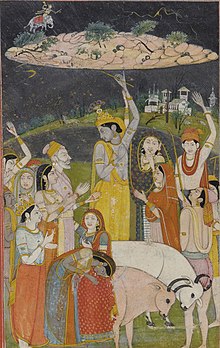Lunar dynasty

In Hindu scriptures, the Lunar Dynasty (चंद्रवंशी, सोमवंशी, Somvansh, Chandravansh) is one of the three principal houses of the kshatriya varna, or warrior–ruling caste. This legendary dynasty was descended from the moon (soma or chandra), while the other principal houses, the Solar Dynasty (Suryavanshi) claims descent from the sun (surya) and the Agnivanshi claim to have been born to the fire-god Agni, with the term vansh referring to descent. Within these family trees sub-branches such as Bharatvansh, Yaduvansh, Puruvansh, Kuruvansh, Pandavansh and others emerged, each named after a prominent progenitor of the line. Throughout history, various South Asian communities have claimed descent from Chandra through these lineages.
The legendary capital of the Lunar Dynasty was Pratisthana, said to be founded by Ila,[1] or by the first Lunar prince, Pururaves, son of Budha, who was the son of Chandra.[2]
Legendary origin
According to the Bhavishya Purana legend, of contested date, the origin of the Lunar Dynasty began with Brahma in the Treta Yuga (second era). Brahma produced Manasputra ("mind born son") Atri, who produced Chandra (the mon god) from his eyes. In the third part of Treta Yuga, Indra sent Chandra, Rohini's husband, to Prithvi (Earth). His capital was Prayag and was a devout worshiper of Vishnu and Shiva. He performed one-hundred Yagyas (oblations) to please the god Mahamaya. He ruled for 18,000 years and then ascended to heaven leaving behind his son Budha.[citation needed]
Yaduvanshi lineage

Of the many branches of the Chandravansh line that has been briefly enumerated, the Yaduvanshi lineage is a major branch. This branch is an offshoot of the Bharatvansh which started with the eldest son of Yayati, Yadu. All his descendants are known as Yadavas of Yaduvansh, meaning descendants of Yadu. Another son of Yayati, Puru started the Puruvansh who were the progenitors of the Kuru and Pandava line of Chandravanshi line of Kshatriyas. Based on the writings of Puranas, the Itihaasa Mahabharata and the Raghuvamsa, Lord Krishna was born into the Yadava branch and is considered an ancestor by Yadav Kshatriyas. During the Mahabharat, Chandravansh was only associated with Yadavas and Shoorsainis. The Bhati, Chandela who built Khajuraho) and Jadaun/Jadeja clans claim that they are Chandravansis. Several Indian castes such as the Sainis of Punjab[3][4] and contiguous regions, The Yaduvanshis (aka Shoorsainis), and the Seuna Yadavas of Devagiri[5] claim descent from the Hindu God Krishna.
Groups claiming Lunar origin
- Ahir
- Banaphar
- Bhati
- Bundela
- Chandel
- Dhangar
- Ghumman
- Haihaya
- Harral
- Jadaun
- Jadeja
- Jadhav
- Janjua
- Kaurav
- Pal-Pali
- Pundhir
- Puruvanshi Thakur
- Rawal Jaisal
- Saini
- Savji
- Tomara
- Yadav
References
- ^ Wendy Doniger (1999). Splitting the difference: gender and myth in ancient Greece and India. University of Chicago Press. pp. 273–. ISBN 978-0-226-15641-5. Retrieved 25 August 2011.
- ^ Samuel Maunder (1851). The treasury of history: being a history of the world : comprising a general history both ancient and modern of all the principal nations of the globe ... Henry Bill. pp. 325–. Retrieved 25 August 2011.
- ^ People of India: Haryana, pp 430, Kumar Suresh Singh, Madan Lal Sharma, A. K. Bhatia, Anthropological Survey of India, Published by Published on behalf of Anthropological Survey of India by Manohar Publishers, 1994
- ^ "In the Punjab in the sub- mountainous region the community came to be known as 'Saini'. It maintained its Rajput character despite migration." Castes and Tribes of Rajasthan, pp108, Sukhvir Singh Gahlot, Banshi Dhar, Jain Brothers, 1989
- ^ Robin James Moore. Tradition and Politics in South Asia. 1979. Vikas Publishing House.
